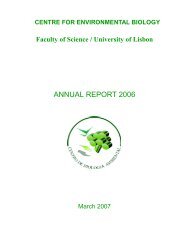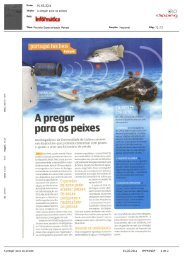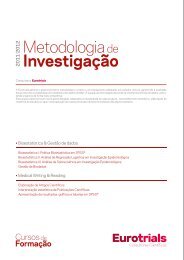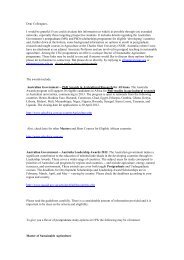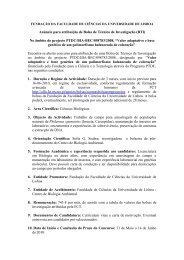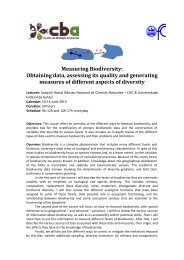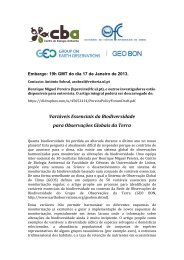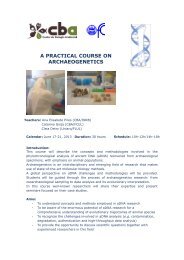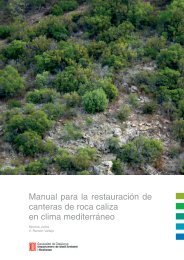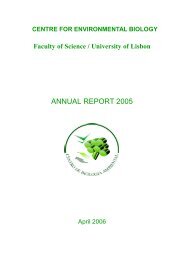European Red List of Vascular Plants - European Commission
European Red List of Vascular Plants - European Commission
European Red List of Vascular Plants - European Commission
You also want an ePaper? Increase the reach of your titles
YUMPU automatically turns print PDFs into web optimized ePapers that Google loves.
The results <strong>of</strong> the assessment <strong>of</strong> CWR show that a<br />
significant proportion <strong>of</strong> species are threatened with<br />
extinction and that many are also likely to become<br />
threatened in the near future unless immediate remedial<br />
action is taken. Crop complexes that are <strong>of</strong> particular<br />
concern include beet, brassicas, oat, lettuce and wheat.<br />
Although a significant proportion <strong>of</strong> the species assessed<br />
are thought to have a stable population trend, a major<br />
concern is that for almost half <strong>of</strong> the species assessed, the<br />
population trend is unknown, underlining our lack <strong>of</strong><br />
knowledge <strong>of</strong> the status <strong>of</strong> these species in the wild. More<br />
than half <strong>of</strong> the species evaluated as threatened or Near<br />
Threatened are in decline and are therefore in urgent need<br />
<strong>of</strong> conservation attention. This loss <strong>of</strong> plant diversity can<br />
occur at both taxonomic (species) and genetic level. It is<br />
difficult, if not impossible, to quantify the loss <strong>of</strong> genetic<br />
diversity within CWR species; however, it must be<br />
faster than the loss <strong>of</strong> species, because there will be some<br />
genetic erosion from the species that remain extant and<br />
complete loss <strong>of</strong> genetic diversity from those species that<br />
become extinct (Maxted et al. 1997c, 2003). It therefore<br />
seems likely that virtually all CWR species are currently<br />
suffering loss <strong>of</strong> genetic diversity to varying degrees.<br />
Maxted et al. (1997c) estimated that 25–35% <strong>of</strong> plant<br />
genetic diversity would be lost between the ratification<br />
<strong>of</strong> the CBD in 1993 and the 2010 Biodiversity Target<br />
date. Loss <strong>of</strong> any genetic diversity means that plants may<br />
not be able to adapt to changing conditions quite so<br />
readily in the future – in a time <strong>of</strong> ecosystem instability<br />
this is a serious concern, since many <strong>of</strong> these species form<br />
the basis <strong>of</strong> our future food security. Further, in terms<br />
<strong>of</strong> the raison d’etre for singling out CWR as a specific<br />
group <strong>of</strong> plants, it is their utility to plant breeders and the<br />
maximum range <strong>of</strong> CWR genetic diversity that breeders<br />
require, so any loss <strong>of</strong> diversity impacts on their potential<br />
utility and thus their value as a natural resource.<br />
At first sight, the level <strong>of</strong> threat in the aquatic plants<br />
group appears low, especially compared to other species<br />
groups bound to aquatic habitats. Aquatic animal species<br />
are among the most threatened in Europe with 44% <strong>of</strong><br />
freshwater molluscs, 37% <strong>of</strong> all freshwater fish and 23% <strong>of</strong><br />
amphibians being threatened with extinction. The main<br />
reason for the low percentage <strong>of</strong> threat in aquatic plants<br />
is that they are mostly widespread and the number <strong>of</strong><br />
restricted endemics is low compared to the other groups.<br />
Among aquatic plants there are species that are adapted<br />
to survive periods without water – this is not the case<br />
for freshwater molluscs or fishes. Some plants are also<br />
quite mobile by using seed distribution via birds or wind.<br />
However, it is notable that the most widespread threat<br />
for freshwater species is water pollution, in particular<br />
from agriculture, although this is not necessarily the most<br />
serious threat.<br />
6.2 Major threats to <strong>European</strong> vascular<br />
plants<br />
<strong>Vascular</strong> plants are subject to the same threats as any<br />
other wild species, which, fundamentally, are caused<br />
by the conflict between supply and demand for natural<br />
resources (Stuart and Adams 1990). The species assessed<br />
are therefore mainly affected by loss, degradation and/<br />
or increased fragmentation <strong>of</strong> their habitats that result<br />
from unsustainable human mismanagement <strong>of</strong> the<br />
environment.<br />
Intensified livestock farming and in particular intensive<br />
grazing activities were identified as the major threats to<br />
the policy species and CWR. Many <strong>of</strong> the species assessed<br />
require a certain level <strong>of</strong> grazing to keep the habitat open<br />
and to protect the species from the encroachment by<br />
plants that compete more aggressively for resources and<br />
light; therefore, while intensive grazing poses a major<br />
threat, a lack <strong>of</strong> grazing is also a threat to some <strong>European</strong><br />
plant populations. This has important implications for<br />
the conservation <strong>of</strong> those species as they require careful<br />
habitat management. The second major threat to the<br />
policy species and CWR is posed by recreational activities<br />
and infrastructure development related to tourism and<br />
urbanisation. Whereas the first leads to species disturbance<br />
such as trampling and habitat degradation, the latter causes<br />
actual habitat loss. The spread <strong>of</strong> invasive alien species is<br />
the third most serious threat for those two groups. Policy<br />
plants are also seriously affected by problematic native<br />
species, <strong>of</strong>ten in the form <strong>of</strong> overgrazing. Collection<br />
<strong>of</strong> wild plant species is causing a loss <strong>of</strong> species and a<br />
reduction <strong>of</strong> their reproductive success, this has been<br />
identified as an important threat for the policy plants in<br />
particular. Some species are used as medicinal plants or<br />
for food, others are collected for their beauty. If species<br />
are known to become rare or threatened with extinction,<br />
it seems to increase their value for collectors and increases<br />
the pressure on those species which in the end proves<br />
detrimental to their survival.<br />
Aquatic plants are also affected by the threats named<br />
above, but ecosystem modifications poses an overall<br />
more severe threat. Drainage and the abandonment <strong>of</strong><br />
traditional grazing activities fall under this category. The<br />
transformation <strong>of</strong> wetland habitats into agricultural fields<br />
and an intensification <strong>of</strong> agricultural activities have severe<br />
effects on aquatic plants. Intensification is accompanied<br />
by a higher input <strong>of</strong> nutrients and pesticides which get<br />
45



